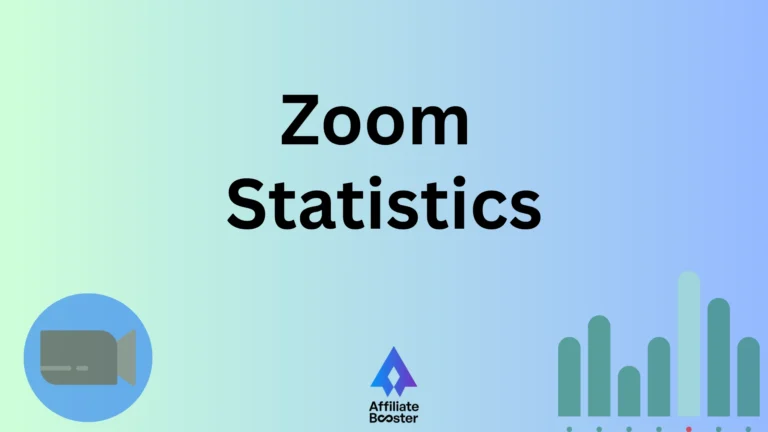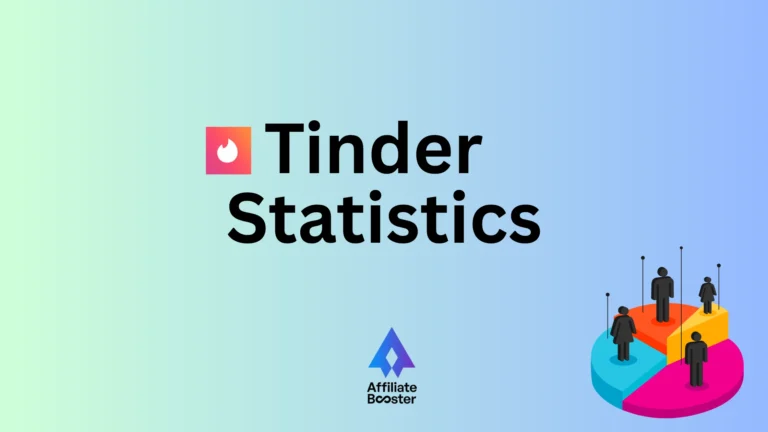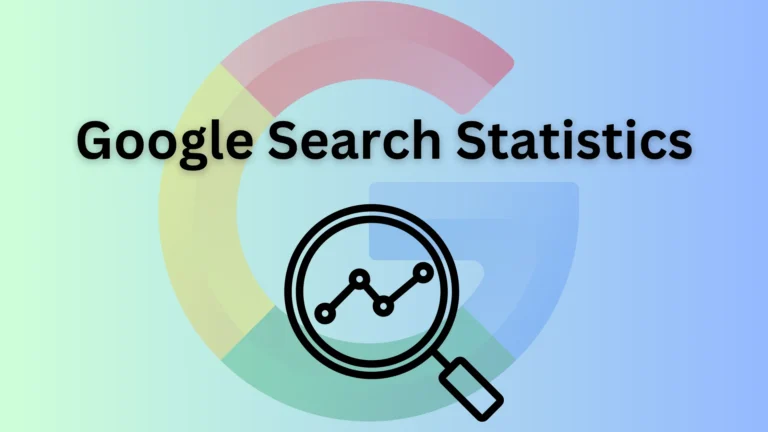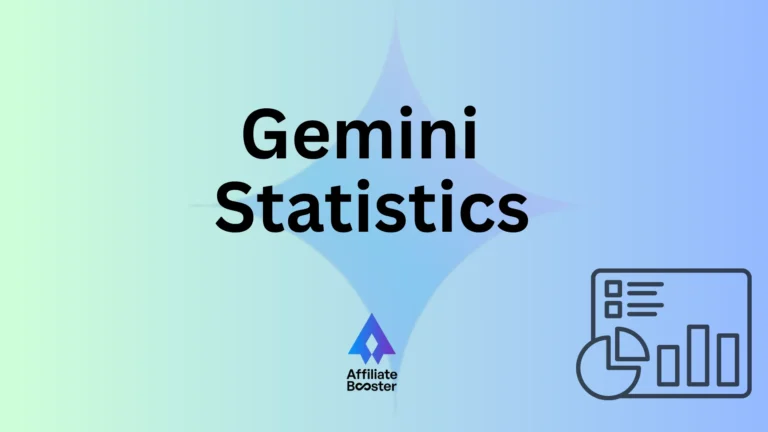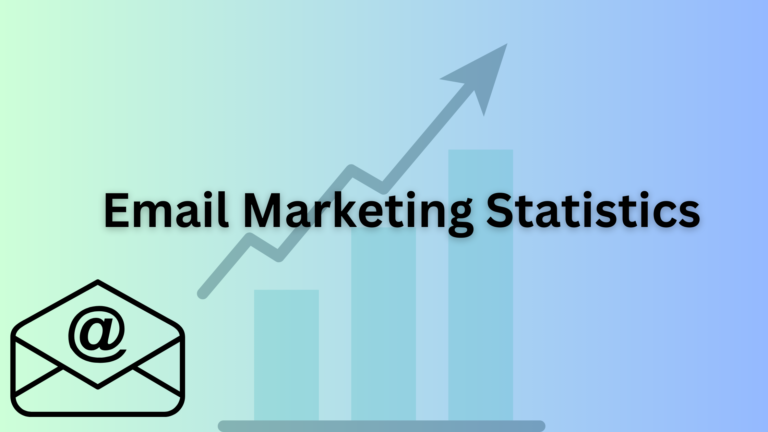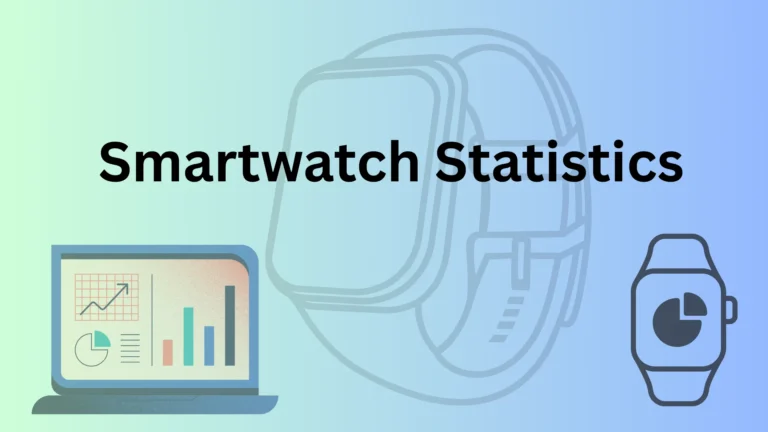Meta AI is changing how we use technology. Since it started, Meta has used AI to improve everything from social media feeds to virtual reality.
With millions of users now on board, the growth is undeniable. So, how many people are using Meta AI in 2025?
The numbers are huge. In 2025, Meta's AI tools have seen a big rise in use, thanks to easy integration, powerful models like Llama 3, and strong leadership from the company.
Let’s take a quick look at the impact of Meta AI users around the world.
Key Facts & Statistics on Meta AI Users 2025
- Meta AI reached 1 billion monthly users in May 2025 across Facebook, Instagram, and WhatsApp
- User base doubled from 500 million in late 2024 to 1 billion by mid-2025
- Over 40 million people use Meta AI daily, even though it is available in only 22 countries
- 4 million businesses use Meta’s AI tools for ads, with campaigns growing 70 percent year over year
- Ranked second worldwide, after ChatGPT, with strong adoption in India and through WhatsApp
- Supports 8 languages and is connected to 3.98 billion monthly users across Meta’s platforms
- Standalone Meta AI app launched in April 2025 to expand beyond integrated features
1 Billion People Now Use Meta AI Each Month
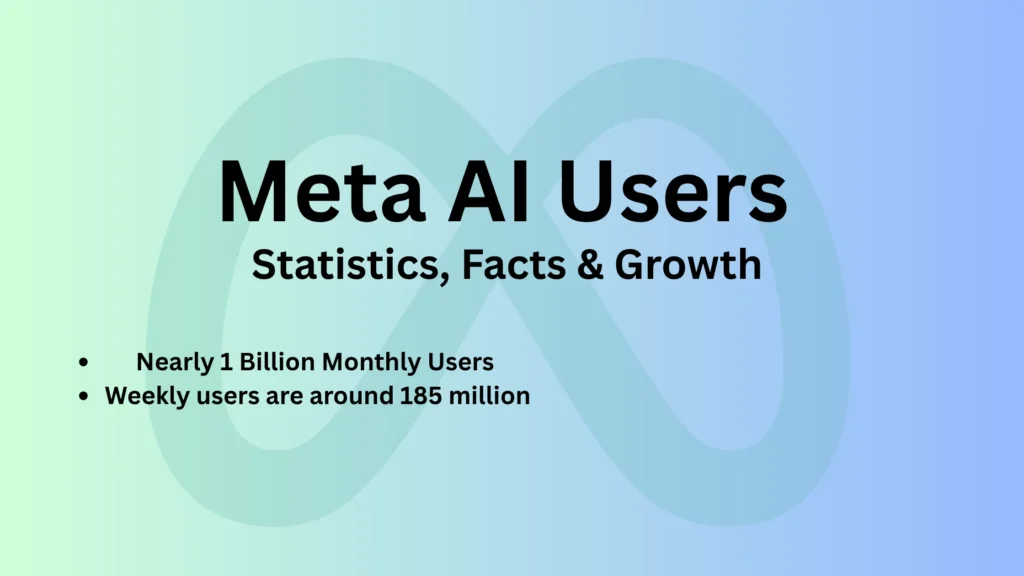
Let's cut straight to the chase: The most significant statistic revealed in Meta's Q1 2025 earnings report (released April 30, 2025) is a monumental milestone.
Meta AI reached nearly 1 Billion Monthly Active Users (MAU) across its platforms by the end of the first quarter of 2025.
This figure is nothing short of extraordinary. Announced by CEO Mark Zuckerberg himself, it highlights the incredible speed at which Meta's AI assistant and features have been adopted. “We're making good progress on AI glasses and Meta AI, which now has almost 1 billion monthly active users,” Zuckerberg stated in the Q1 2025 earnings call.
To put this into perspective, Meta's entire Family of Apps (Facebook, Instagram, WhatsApp, Messenger) reported a colossal 3.98 billion monthly active people (MAP) and 3.43 billion daily active people (DAP) in the same quarter. Reaching nearly 1 billion MAU means that roughly a quarter of Meta's global monthly user base was already interacting with its AI features in early 2025.
This level of penetration, achieved relatively quickly since Meta AI's wider rollout began in earnest, underscores the power of integrating AI directly into platforms people use daily.
This figure also brings Meta tantalizingly close to, or perhaps even achieving, Zuckerberg's ambitious goal set earlier in the year: “I expect that this is going to be the year when a highly intelligent and personalized AI assistant reaches more than 1 billion people, and I expect Meta AI to be that leading AI 1 assistant.”
Achieving this landmark number so early in 2025 showcases the rapid acceleration of Meta AI's growth.
Sources : BBNtimes
The Growth of Meta AI
The journey to nearly one billion users wasn't instantaneous, but it has been remarkably swift. Tracking the reported user numbers reveals a steep upward curve, demonstrating accelerating user interest and Meta's expanding rollout.
Table: Meta AI Monthly Active User (MAU) Growth (Reported/Estimated)
| Time Period | Reported/Estimated MAU | Source Context |
| Late 2024 | ~500 Million | Demand Sage, AI Magazine reports |
| January 2025 | ~700 Million | EasyEquities, THE Journal reports |
| End of Q1 2025 | Nearly 1 Billion | Meta Q1 2025 Earnings Report |
Note: Earlier figures are based on reliable tech reporting and estimates; the Q1 2025 figure is from Meta's official earnings.
What fueled this exponential growth? Several factors converged:
- Seamless Integration: Unlike standalone AI apps that require users to seek them out, Meta AI was embedded directly into the search bars, chat interfaces, and content creation tools of WhatsApp, Messenger, Facebook, and Instagram. This reduced friction dramatically.
- Vast User Base: Leveraging the existing billions of users on its platforms provided an unparalleled launchpad for AI adoption.
- Feature Expansion: Continuous improvements to the underlying Llama models and the introduction of new AI features (like improved image generation) kept users engaged.
- Geographic Rollout: While initially launched in a limited number of countries (reportedly 22 by late 2024, excluding the EU initially), Meta has gradually expanded availability.
- Standalone App Launch: In early May 2025, Meta introduced a dedicated, standalone “Meta AI” app, offering a focused experience and potentially attracting new users or deepening engagement with existing ones.
This multi-pronged strategy has clearly paid off, cementing Meta AI's position as one of the most rapidly adopted AI services globally in 2025.
Meta AI Everywhere: Integration Across the Ecosystem
Understanding the Meta AI user statistics 2025 requires looking beyond a single app. Until the recent launch of the dedicated app, Meta AI primarily existed as an integrated layer across Meta's core services. Users encountered and utilized its capabilities in various familiar contexts:
- Conversational AI: Chatting directly with Meta AI within WhatsApp, Messenger, and Instagram Direct Messages for information, brainstorming, or fun.
- In-Chat Assistance: Invoking Meta AI within group chats to settle debates, plan events, or generate content collaboratively.
- Enhanced Search: Using AI-powered search within the apps to get more comprehensive answers beyond simple link results.
- Creative Tools: Leveraging generative AI to create unique stickers, edit photos (e.g., style transfer), or generate images from text prompts directly within chats or posts.
- Content Summarization: Exploring AI features to summarize long chat threads or get updates from Facebook Groups (features may vary by rollout stage).
- Smart Glasses: Interacting with Meta AI hands-free via Ray-Ban Meta Smart Glasses for real-time information and features.
- The New Hub: The standalone Meta AI app now provides a central place for users to interact with the assistant, discover new prompts, and manage their AI interactions.
This deeply integrated approach is key to Meta's strategy. It makes AI accessible and useful in the flow of existing digital behaviors, rather than requiring users to learn a completely new tool or platform.
The underlying engine for many of these experiences is Meta's powerful Llama series of large language models, particularly the Llama 3 iteration rolled out more broadly in 2024/2025.
This connection means that Facebook AI users, Instagram AI users, and WhatsApp AI users are often interacting with the same core intelligence, just tailored to the specific platform's context.
Who's Using Meta AI? A Glimpse into Demographics & Regions 2025
While the headline user numbers are impressive, understanding who these nearly one billion users are provides deeper insight.
Unfortunately, detailed, publicly available Meta AI user demographics specific to its AI features remain scarce as of mid-2025.
Meta hasn't released granular breakdowns by age, gender, or precise location specifically for AI usage in its official reports yet.
However, we can infer some characteristics and regional trends:
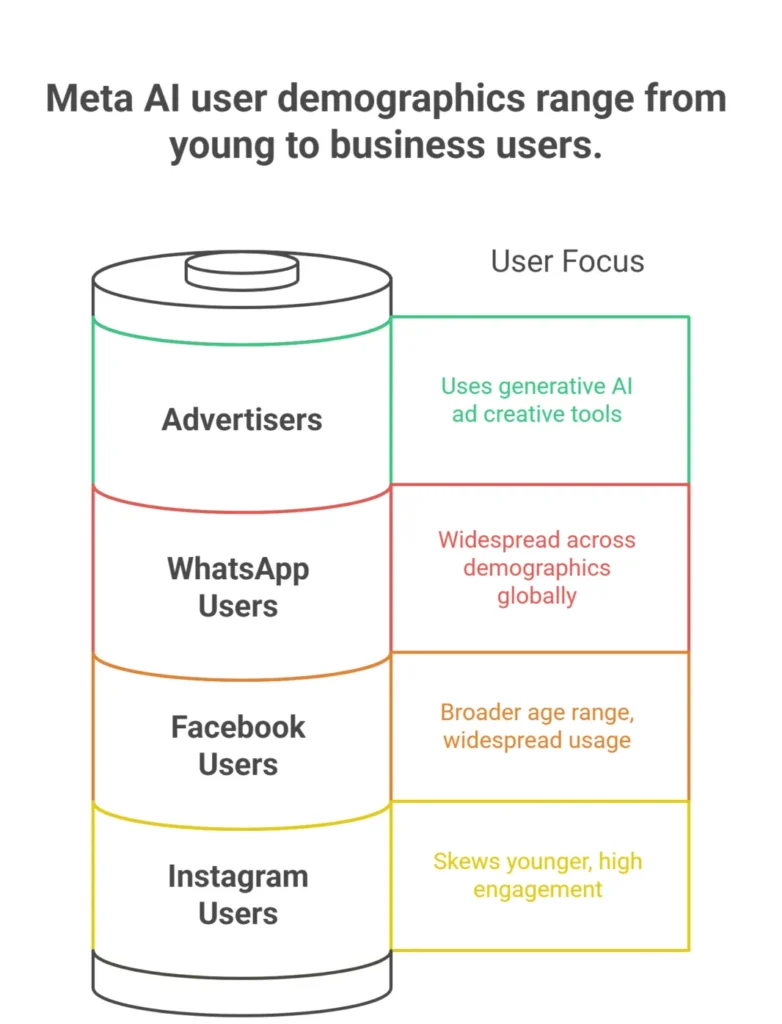
Platform Proxy: AI usage likely mirrors the demographics of the underlying platforms. Instagram generally skews younger (millennials, Gen Z), while Facebook has a broader age range. WhatsApp usage is widespread across many demographics globally. Therefore, Meta AI users likely span a wide age spectrum but may see higher engagement concentration among younger demographics active on Instagram and WhatsApp.
Regional Rollout: Meta AI's initial rollout focused on the US and select other countries (reportedly 22 by late 2024). India was cited in some reports (Statista) as a major early market, likely due to the massive user base of WhatsApp and Instagram there. The United States is also a critical market, particularly for business adoption of AI tools.
Key Platform Markets: Given Instagram's massive user bases in India (362 million), the US (169 million), and Brazil (134 million) (Source: Electro IQ, citing recent data), these countries are almost certainly hotspots for Meta AI usage as well.
Language Support: The initial Llama 3 models powering Meta AI emphasized high performance in English but included training data for several other languages (reportedly German, French, Spanish, Italian, Portuguese, Hindi, Japanese). Broader language support is crucial for deeper global penetration.
EU Considerations: The delayed rollout and ongoing regulatory discussions (like the Digital Markets Act compliance) in the European Union mean this large, digitally savvy population may have had slower initial uptake compared to regions like the US or India. Meta noted in its Q1 2025 report that potential changes required by the EU could impact user experience and business there significantly by Q3 2025.
Business Users: While consumer use dominates, Meta reported 4 million advertisers using its generative AI ad creative tools by early 2025. Business use cases, particularly in messaging and advertising, represent another important user segment.
The Big Takeaway: While we know Meta AI usage is massive and geographically widespread, more detailed official data is needed to fully understand the specific Meta AI user demographics and regional nuances in 2025. Adoption likely follows the paths of least resistance – integrated into the platforms people already use heavily in regions where it's readily available.
Source: Forbes
Llama 3: The Open-Source Engine Driving Meta AI
Behind the conversational interfaces and creative tools lies Meta's advanced large language model series: Llama. The Llama 3 family, introduced with much fanfare, represents a significant leap in capability and is the primary engine powering Meta AI experiences in 2025.
Key aspects of Llama 3 include:
Open-Source Approach: Unlike competitors like OpenAI's GPT series or Google's Gemini (though Gemini models also have varying accessibility), Meta has largely pursued an open-source strategy with Llama, making the models (or at least their weights for certain versions) available to researchers and developers. This fosters innovation and broader adoption.
Massive Scale Training: Llama 3 models were trained on an immense dataset reportedly exceeding 15 trillion tokens of text and code, utilizing vast computing infrastructure (like over 16,000 NVIDIA H100 GPUs).
Multiple Model Sizes: Recognizing different needs, Meta released Llama 3 in various sizes:
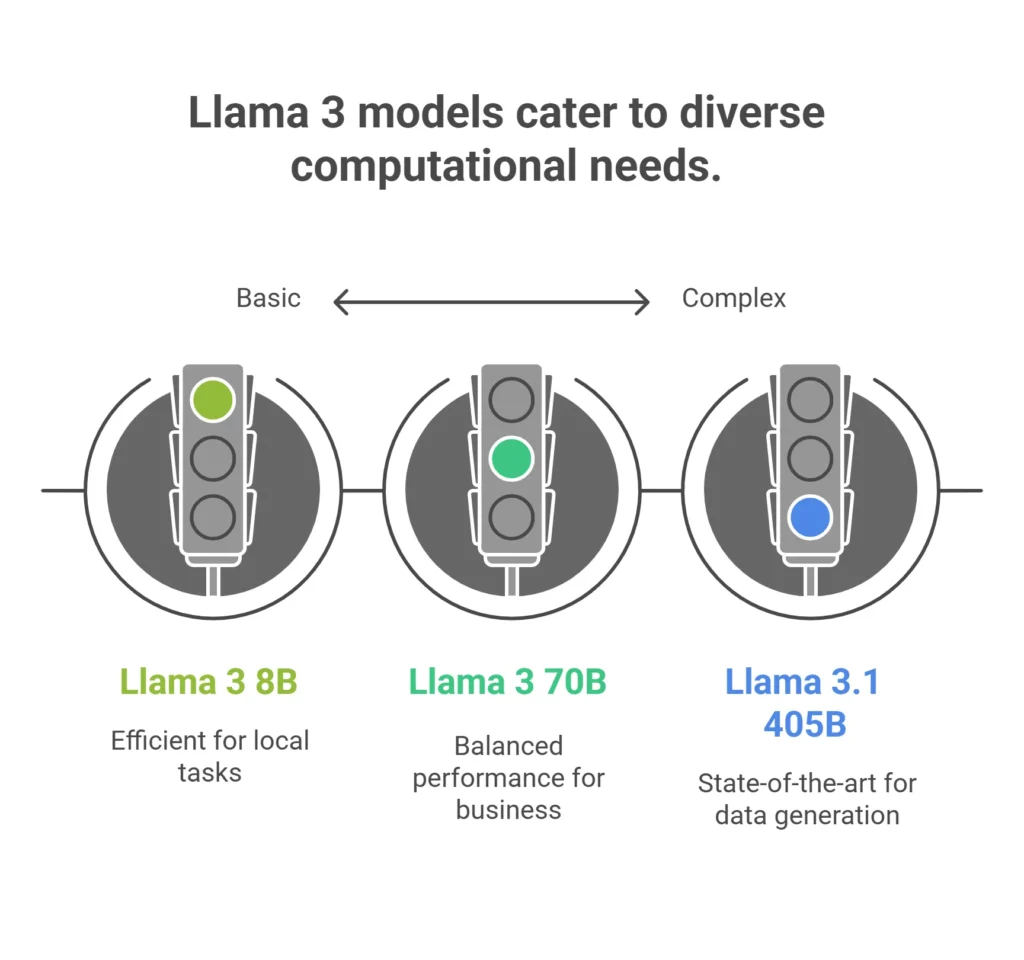
- Llama 3 8B (8 Billion Parameters): Optimized for efficiency, capable of running on consumer hardware like laptops and even some mobile devices. Ideal for on-device tasks and basic AI assistance.
- Llama 3 70B (70 Billion Parameters): A powerful model offering a strong balance between high performance and manageable resource requirements. Suitable for more complex tasks and enterprise applications.
- Llama 3.1 405B (405 Billion Parameters): Meta's largest and most capable model, designed to compete with the best proprietary models like GPT-4 and Gemini Advanced in reasoning, knowledge, and coding benchmarks. It requires significant infrastructure to run.
Table: Llama 3 Model Comparison (Simplified 2025 Perspective)
| Feature | Llama 3 8B | Llama 3 70B | Llama 3.1 405B |
| Target Use | On-Device, Basic Tasks | Enterprise, Balanced Performance | Frontier Research, Complex Tasks |
| Performance | Good, Efficient | Very Strong | State-of-the-Art (Open Weights) |
| Hardware Needs | Consumer-Level | Multiple GPUs / Cloud | Significant Infrastructure |
| Best For | Efficiency, Local Execution | Robust Business Apps | Highest Capability, Data Gen |
Source: Adapted from analysis like Liquid Metal AI.
- Rapid Development: Meta is continuously iterating, with talks of Llama 4 already emerging, indicating a fast-paced development cycle to maintain competitiveness.
While direct “Llama user” statistics are hard to pin down (as most users interact via Meta AI), the rapid uptake and positive reception of Llama 3 within the developer community contribute significantly to the overall strength and capability of the Meta AI ecosystem experienced by end-users in 2025.
Beyond User Count: AI's Impact on Engagement & Business
The Meta AI statistics 2025 story extends beyond sheer user numbers. The integration of AI is demonstrably impacting user engagement and Meta's core business operations:
- Enhanced User Experience:
AI powers better content recommendations in Facebook and Instagram feeds, leading to increased time spent on the platforms. AI Magazine noted this trend, highlighting how AI boosts engagement.
Improved Advertising: This is a critical area.
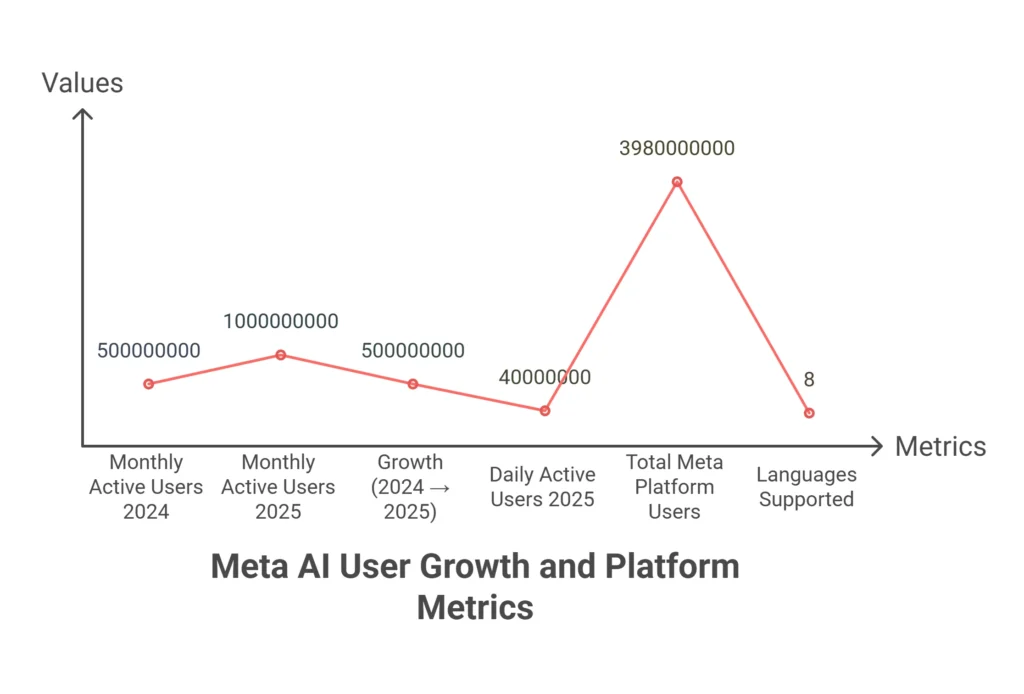
- AI-Driven Tools: Over 4 million advertisers were using Meta's generative AI tools (like text variations, image generation for ads) as of early 2025 (Source: EasyEquities Blog).
- Performance Boost: AI optimizes ad targeting and delivery. Meta's Advantage+ shopping campaigns, heavily reliant on AI, hit a $20 billion annual run rate early in the year, growing 70% YoY (Source: EasyEquities Blog). AI improvements reportedly led to a 5% rise in ad conversions on Reels (Source: Influencer Marketing Hub).
- Efficiency: AI helps automate ad creation and management, making it easier for businesses (especially small ones) to advertise effectively.
- Business Messaging: Meta sees huge potential in AI-enhancing business-to-consumer interactions via WhatsApp and Messenger, automating customer support and facilitating commerce (Source: Simply Wall St, TradingView).
- Strategic Investment: Meta's commitment is underscored by its massive capital expenditures, projected at $64 billion to $72 billion for 2025, largely earmarked for AI infrastructure (data centers, custom chips like MTIA, and GPUs). This dwarfs previous spending levels and signals AI's centrality to Meta's future (Source: Multiple earnings reports/analyses).
In essence, AI in 2025 is not just a user-facing feature; it's becoming integral to Meta's operational efficiency, user retention, and, crucially, its multi-billion-dollar advertising engine. AI engagement translates directly into business value.
The Road Ahead: 2025 Challenges and Future AI Projections
Despite the phenomenal growth and nearly one billion monthly users, the journey for Meta AI in 2025 and beyond isn't without hurdles and big questions:
Sustaining Growth: Can Meta AI continue its rapid user growth beyond the 1 billion MAU mark? This depends on successful rollouts in remaining regions (like navigating EU regulations), continuous feature innovation, and potentially driving more usage of the standalone app.
Monetization: While AI is boosting the existing ad business, direct monetization of Meta AI features (e.g., premium AI assistant tiers, business-specific tools) is still nascent. Zuckerberg suggested that significant direct revenue generation is likely beyond 2025, following Meta's typical playbook: build product, scale users, and then build the business.
Regulatory Scrutiny: The EU's Digital Markets Act (DMA) poses a significant challenge. Meta acknowledged in its Q1 2025 report that required changes to its data handling and subscription models in Europe could materially impact user experience and revenue as early as Q3 2025. Privacy concerns remain a constant factor globally.
Intense Competition: Meta is battling giants like Google (with Gemini and Search Generative Experience), OpenAI (ChatGPT), Microsoft (Copilot), Apple (rumored AI enhancements), and others. Maintaining a competitive edge requires relentless innovation and investment.
Cost of Infrastructure: The enormous $64-72 billion CapEx for 2025 highlights the staggering cost of building and maintaining leading-edge AI infrastructure. Managing these costs while delivering returns is a key challenge.
Responsible AI: Ensuring fairness, mitigating bias, preventing misuse, and maintaining user trust are ongoing, critical challenges for any large-scale AI deployment.
Future Integration: The roadmap includes deeper integration into hardware like next-gen AI smart glasses and potentially the Metaverse (Reality Labs division), creating more immersive and seamless AI experiences. Analyst projections for Meta's overall revenue growth in 2025 (around 13% YoY expected by some) are heavily tied to the successful execution of its AI strategy.
The future of Meta AI involves navigating these complexities while continuing to innovate and scale. The foundation laid in early 2025 is incredibly strong, but the competitive and regulatory landscape remains dynamic.
Quicklinks:
- Instagram Reels Statistics: Growth, Engagement & ROI
- How Many People Use Social Media?:(Social Media Users Stats)
- WhatsApp Statistics: Usage, Revenue & Growth Insights
- CRM Statistics & Trends You Must Know
- Google Search Statistics: Key Facts and Trends
- Tinder Statistics | Users, Revenue & Growth Insights
Conclusion: Meta AI's Billion-User Era Has Dawned
To conclude, in 2025, Meta AI has reached a major milestone, with nearly 1 billion monthly active users. By integrating AI into Facebook, Instagram, WhatsApp, and Messenger, Meta is enhancing user experiences and boosting engagement.
Despite challenges like regulation and high development costs, Meta's large investments show its strong commitment to an AI-driven future.
As the year progresses, Meta AI will play a bigger role in personal assistance, creativity, and social connections, marking the start of a new chapter for both Meta and its users.
Sources: (Statista, Meta AI, BBNtimes, Techcrunch, BusinessInsider, Resourcera)
